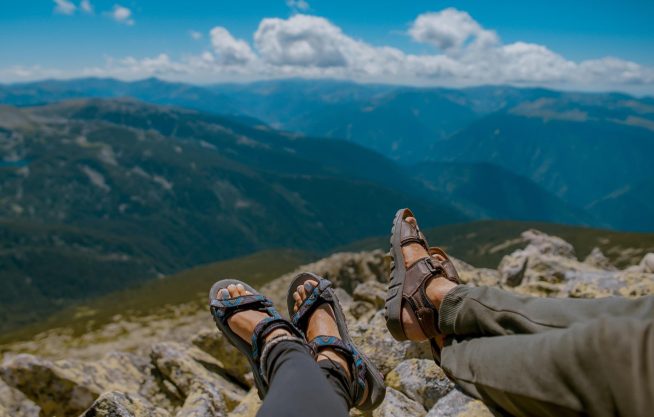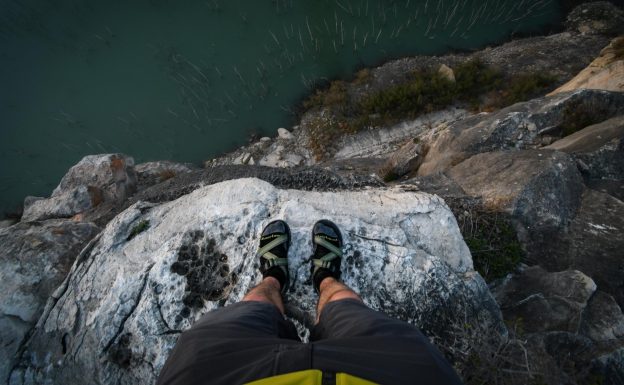
Introduction
Your hiking trip begins long before you step foot onto your trail. After choosing where you’re headed, you’ve got to start preparing what to wear for your hike. Every article of clothing from head to toe matters –– with footwear being arguably one of the most crucial items to take note of.
There’s a myriad of options to select from when it comes to choosing footwear. You may assume that close-foot options are always the go-to options, but we’re here to show you that hiking with comfortable sandals can prove to be advantageous in many different situations. They can be a refreshing alternative to otherwise stuffy shoes, with their unbeatable ventilation and waterproof qualities. By the end of our guide, you’ll be ready to purchase the best hiking sandals you’ve ever seen.
Essential Considerations
What options are there, which to choose, where and when to wear them? Fret not, we’ll guide you through it all.
Terrain
When can you wear hiking sandals depends on where you’ll be heading, and let’s start with where you can’t wear them. It’s no surprise that hiking sandals aren’t the ideal choice for every hike –– people often opt for hiking shoes and boots when attempting riskier landscapes. Unfortunately, some terrains are just too harsh for hiking sandals, and it’ll be incredibly reckless and unsafe to leave a hiker vulnerable to environmental hazards without proper protection.
One common example of a harsh environment includes rocky terrains. Areas where you have to traverse around all kinds of rough, tricky bounders, are better suited for closed-toe footwear such as hiking boots and shoes. Because sandals have an open-toe design, they won’t provide sufficient protection against rocky grounds. Moreover, hiking sandals should also not be worn on hikes with thick or tall foliage. This obstruction greatly reduces your field of vision, and you’ll be unable to catch potential dangers lurking within the hike –– such as sharp edges of rocks, dangerous creatures like snakes, and poisonous wild plants like ivy. In such cases, wearing tall hiking boots will offer you greatly-needed protection.
With those out the way, when should you use hiking sandals, then? We encourage you to use them on trails with level ground, firm, and familiar paths where you’re sure that the route does not contain particularly difficult obstacles, such as steep inclines or muddy areas.
Ankle Support
Different sandal designs will give differing degrees of support for your ankles. In our experience, we’ve found that the best are ones with a strap that holds the back of your heel, as well as side straps that connect to the sole. Better yet, get ones with adjustable straps that’ll allow you to match them perfectly to your feet.
However, regardless of how much they can be tightened, hiking boots will always give an extra boost of ankle support. Hence, for those who suffer from fragile ankles, you might want to think twice before opting for hiking sandals for your next excursion.
Fastening
Pay attention to the fit of the sandals! Get a pair that’s too tight and you’ll get blisters, yet wearing a pair that’s too loose will cause your feet to be inadequately protected. Fastening allows you to adjust the hiking sandals according to your feet measurements, thus leaving you with a comfortable fit yet with enough space to move about freely.
Although hiking sandals come with three types of fastening options, you should always choose the one that gives your feet the best amount of comfortability and ankle support. The first type of fastening is the good ole’ laces. Everyone’s bound to be familiar with these tried-and-tested forms of fastening –– however, it can cause a great deal of annoyance when the laces come undone. Plus, it might even pose as a tripping hazard! The second type of fastener is Velcros, where you can stick the top and bottom straps together to tighten or loosen the sandals. Lastly, the third option uses an adjustable buckle that holds your sandals in place.
Surface Grip
Bearing in mind the limitless amount of designs of hiking sandals, it is almost impossible for us to recommend the best in confidence; however, we can offer you some qualities to take into consideration when choosing your favorite sandal design.
First of all, the grip design of the sole needs to be suitable for hiking. The ones you’ll need must be sturdier than those for leisure, providing your feet with a firm grip over a variety of surfaces. This is crucial to prevent losing your footing and tripping over challenging terrains.
Secondly, the thickness of the sole needs to be appropriate for hikes. All kinds of obstructions, (such as rocks and cactus spikes) may snag the bottom of your sole on a hike, so you’ll need to come extra prepared. We recommend choosing hiking sandals with thicker soles, as these will act as a better barrier compared to ones with thinner soles.

Advantages of Hiking Sandals
Now that we’ve cleared some things to take into consideration when opting for hiking sandals, let’s move on to the benefits that they bring.
Prevents Discomfort From Blisters
If you choose to wear hiking boots and shoes, you’ll have to pair them with hiking socks to reduce the chance of blistering. However, the added material can be extremely uncomfortable and cause excessive sweating, especially during the hotter months. This problem is further exacerbated when wearing cotton socks, which are known to retain significant amounts of moisture; this may even lead to the formation of feet odor and blisters.
In such cases, you can count on hiking sandals as being the perfect solution to this. Because of their open-toe design, sandals allow for good air circulation and ventilation, which keeps your feet cool and dry. With sweat production vastly reduced, the chance of you developing blisters and feet odor is greatly minimized too!
Best Suited For Wet Terrains
Similarly, this open-toe design allows sandals to be the best option when navigating through wet terrains. You’re able to trudge through rivers, ponds, and lakes without thinking twice! Hiking sandals allow water to flow freely in-and-out of the sandals, which results in quicker evaporation. This means that you don’t need to spend extra time drying and leaving them out in the sun every time they get wet!
On the contrary, hiking boots and shoes get significantly more uncomfortable and heavy once moisture has soaked into the soles.
Also read: Sneaker Value: How to Pick the Right Sneakers
Lightweight
Carrying too much weight whilst hiking can get extremely burdensome, especially when you’re just starting as a beginner. Hence, we recommend opting for hiking sandals over boots, only when the environment you’re planning to adventure into allows for it. There are many types of hiking sandals available, but make sure to not scrimp out on quality just to get the lighter ones! A couple of extra ounces between sandals won’t make a big difference to your load.
Conclusion
For the right conditions, hiking sandals are the perfect alternative for those of us who prefer comfort and freedom for our feet. Not only are they lightweight, cooling, and quick-drying, hiking sandals can even provide the same ankle support and surface grip that hiking boots offer.






